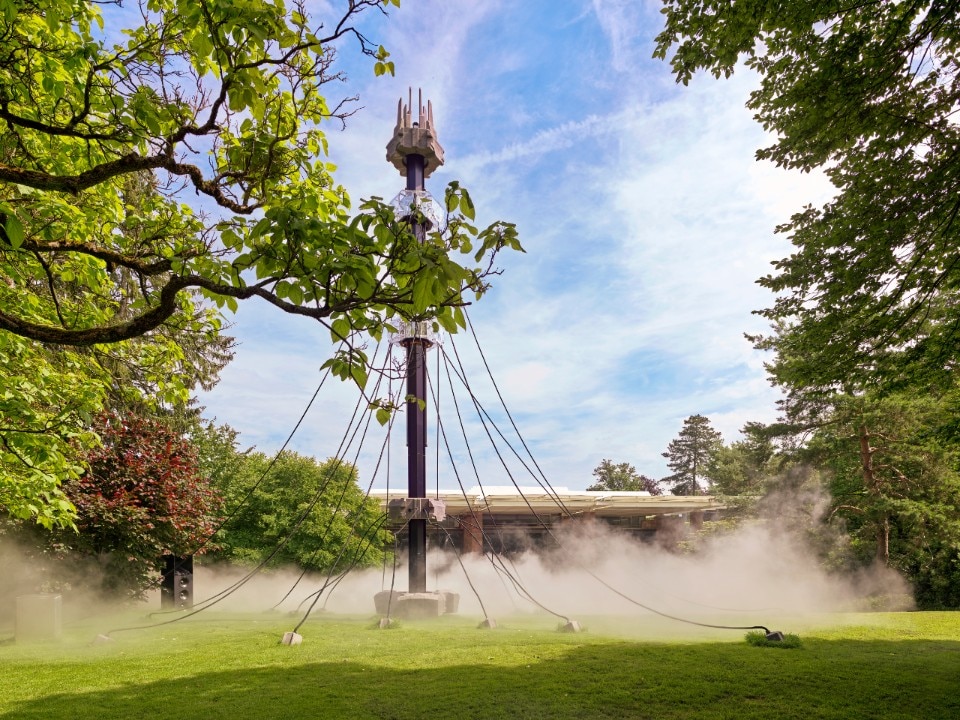Visiting Basel during Art Week is an extraordinary opportunity to enrich one’s thoughts on aesthetics, politics, social issues, and ... well, design. Art and design are two sides of the same coin. Each work, to exist and not remain an idea, must be conceived, developed, realized, designed, and produced.
With this perspective, one can find surprising works that reference design, using furniture and architecture as objects or subjects. The entire city hosts numerous events and happenings that offer significant opportunities for reflection.
The Fair
This year, one of the most surprising things in the always cramped battery stands, one that makes you slow down and actually stop, is Philippe Parreno’s new work, Moving Lamps (2024). Sliding on vertical cables, these lamps create luminous vertigo for interiors that can afford it.
Ugo Rondinone’s new work, The alphabet of my mothers and fathers (2024), transforms household objects into ideal letters of the family alphabet, turning them into precious (gilded) letters to be translated.
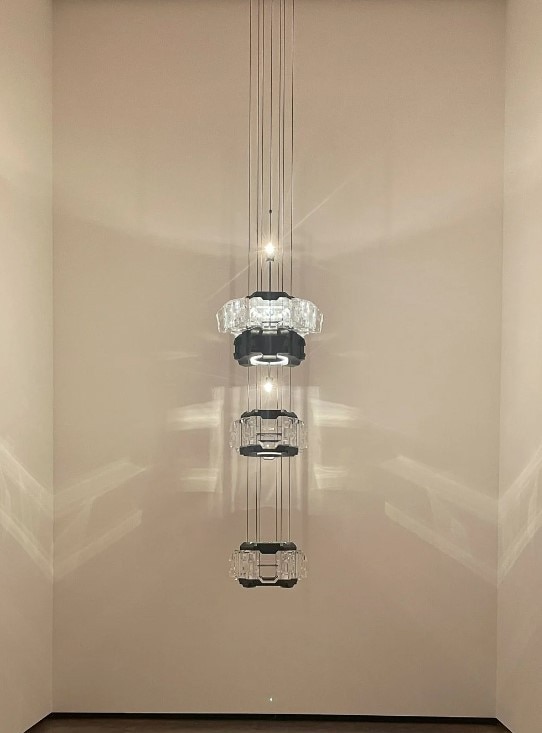
Among the corridors, there is also a dazzling tribute to Gio Ponti by Thomas Demand in his series of portraits (Concattedrale Gran Madre di Dio, 2024). He chooses masterpieces of modern architecture and portrays them in detail and in fragments.

Speaking of monuments (and Ponti’s latest work in Taranto is certainly one), the work of Jessica Kairé is a pleasant discovery. The South American artist deals with memory, colonialism and the social impact of Guatemalan monuments influenced by the United States. She redesigns the pedestals of these monuments, making them ephemeral, textile, soft, foldable, even wearable, but always in full scale.
Finally, there is a beautiful piece of “applied art” by Keith Haring (Untitled - Crib and Dresser Set, 1986), a unique work dedicated to children, consisting of a crib and a changing table.
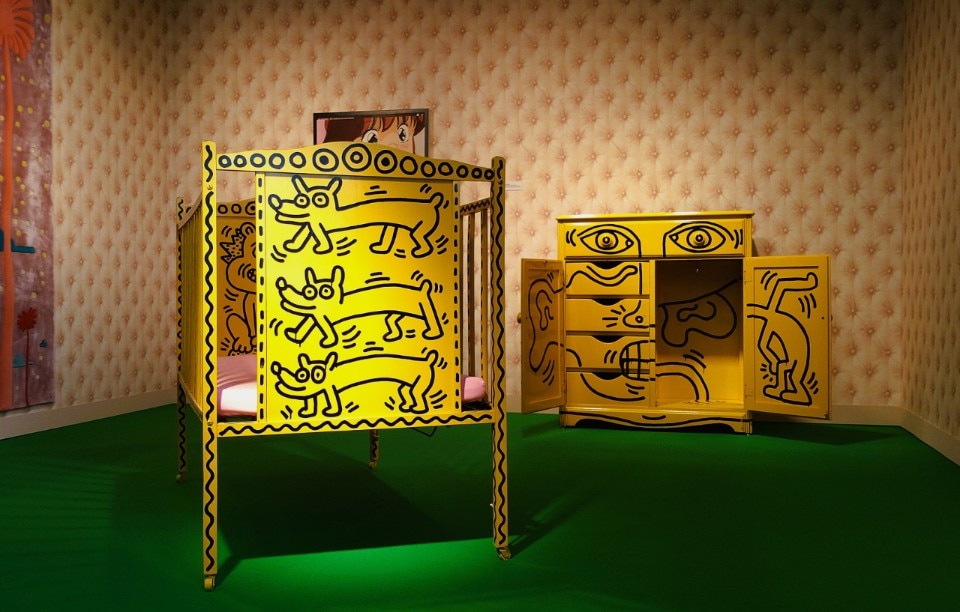
Unlimited
Moving on to the Unlimited pavilion, where the works are too large for traditional stands, the selection begins outside. A mammoth tractor-trailer with Italian license plates contains and transports Emilio Isgrò’s La Formica Vagabonda (The Wandering Ant) (2024). This work started in Sicily, traveled across the peninsula, crossed the Alps, and parked at the entrance to the Basel fair.
Inside, among large sculptural works that often speak the language of architecture, Alicja Kwade presents ParaPosition (2023). It consists of two twisting rectangular frames that support large, suspended, precarious stones. The work provides a resting place and vantage point for a bronze sculpture in the form of a chair that sits just below an embedded boulder.

Away from the catwalks, Martin Margiela’s works highlight his sensibility and experience, focusing on themes of fur, skin, and surfaces in contact with the body. Podium (2024) is a minimalist metal platform with a “surreal” covering that embraces the attraction of opposites and undergoes an intimate transformation.
Finally, Nathalie Du Pasquier’s Così Fan Tutte (2015-2023) occupies a large space and feels almost endless. This series of tall totemic columns, complemented by small painted panels, creates a polychrome, three-dimensional landscape inspired by Mozart’s famous opera.
Liste
The Liste Pavilion, an independent section of the fair for emerging galleries, continues to offer new discoveries that explore contemporary design themes in all their forms.
Papageorgiou’s lounge chair sculptures reflect on leisure, inviting a paradoxical reflection on capitalist pleasure systems and their role in the depletion of planetary resources.
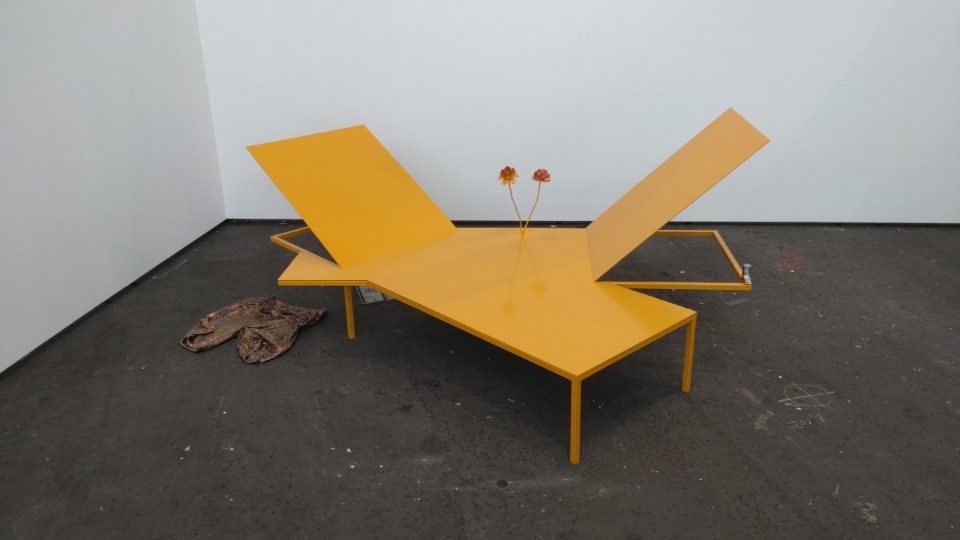
Martin Otter’s The Play (2024) is both simple and complex, with large plywood sheets forming sculptural structures that fill the space and direct the gaze like primary architecture.
Kaare Ruud surprises with the visual and design association between drawing pencils and wooden construction techniques. His Untitled Pencil Sculpture (2024) are small houses made of eaten pencils, repurposing typical village social typologies.
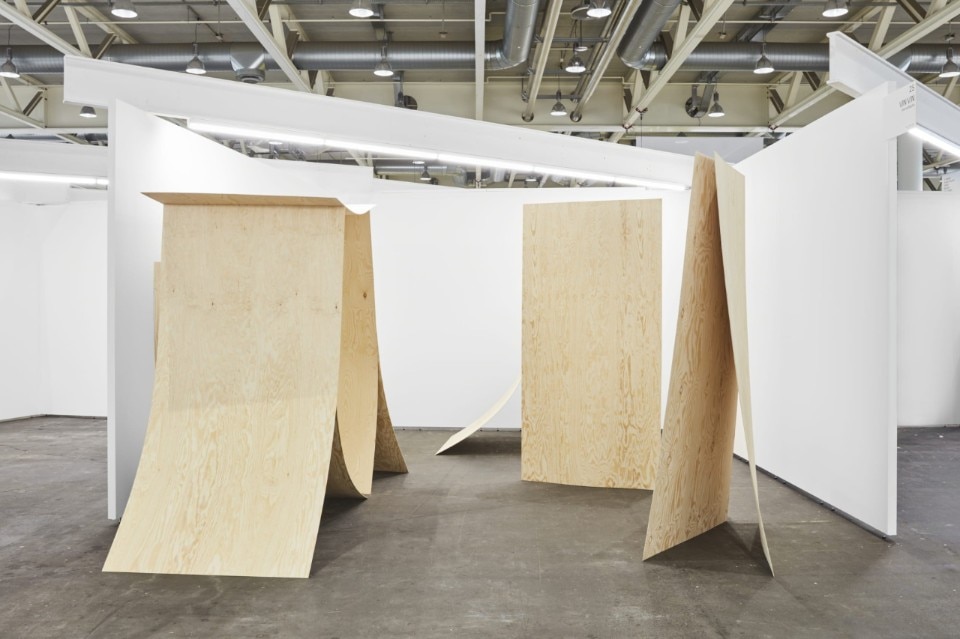
Swiss Art+Design Awards
In the pavilions dedicated to the Swiss Art+Design Awards, which have been presented at Art Basel for the past few years, one standout is the award to Paola De Martin. Through the history of contemporary design and transdisciplinary work, she addresses urgent current issues by investigating classism and cultural discrimination.
Among the projects on display, one stands out for its scale and originality. The Lausanne-based Studio Detritus, which won last year’s prize with a project that referenced the spaces of the fair itself, presents Gum Gum (2024), a temporary, parasitic overnight housing program for young artists who can’t afford the high price of accommodation during the fair. Enigmatic handles appear on the white panels of the exhibition’s partitions. When needed, these handles can be turned or lifted to open and reveal complementary spaces that house beds, closets, and work surfaces.
Design Miami.Basel
There was also a section of the fair dedicated exclusively to design, Design Miami. However, it’s struggling to recover after the post-COVID crisis, at least in terms of the contemporary design research it has strongly supported and represented over the last twenty years. The presence of almost all the Parisian galleries, combined with last year’s inauguration of Design Miami.Paris, points to an increasingly uncertain future for the Swiss stage.
In addition to the exclusive presentation of modernist pieces (including many past masterpieces), there was a modest tribute to Gaetano Pesce with a selection of objects displayed in a corner of the entrance atrium. The most interesting novelty was the new gallery downtown+, which focuses on the Japanese contemporaries Ishigami and Yoshioka, dedicating an independent space to a special project: A set of tables and chairs designed by Bob Wilson in 1986 for the first performances of Hamletmachine in New York and Hamburg.
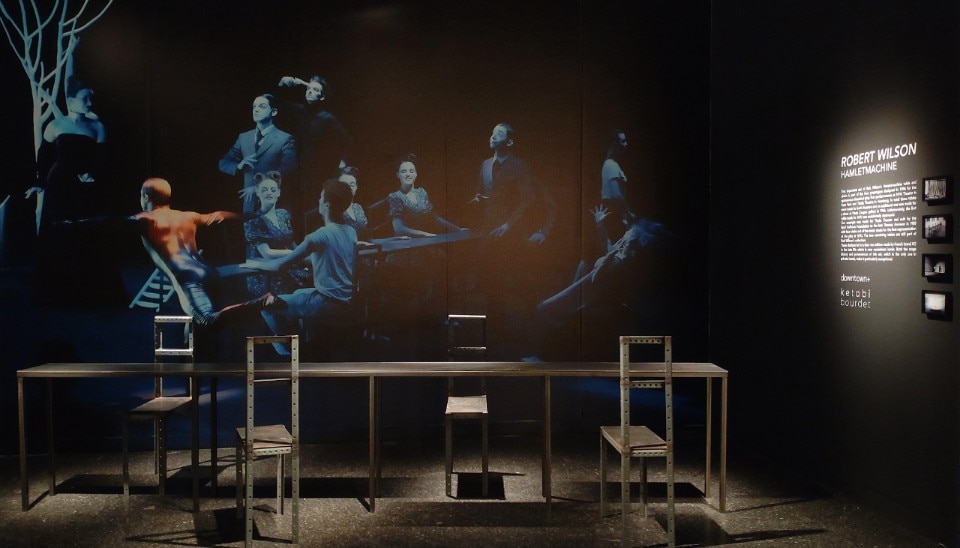
Parcours
Stepping out of the exhibition halls and getting lost in the Parcours itinerary, featuring site-specific works in private buildings and public spaces in the city, is always a fascinating and interactive experience with design. This year, the works explore transformation and circulation in the processes of commerce and globalization. They are clustered around the Fair and Commercial District, where signs of the real estate crisis are evident, making it possible to find them among empty and working shops, a hotel, a restaurant, a distillery, and other everyday spaces in the city.
Among them is Iris Touliatou’s work, which installs humming groups of indoor fountains in a small abandoned casino-amusement arcade. Titled Mothers, it offers water to visitors, creating a contrast between the value of money that used to flow here and the value of the liquid that makes up our bodies. Meanwhile, on the side of a church overlooking a public garden, Eric Hattan presents Stilles Leben (2024), a meditative installation and performance work made with abandoned everyday objects. The artist salvages and recycles these objects by creating continuous sculptures, aggregating, moving, and seamlessly reassembling them. It’s a beautiful homage to Fischli & Weiss’ masterpiece Equilibres - A Quiet Afternoon.
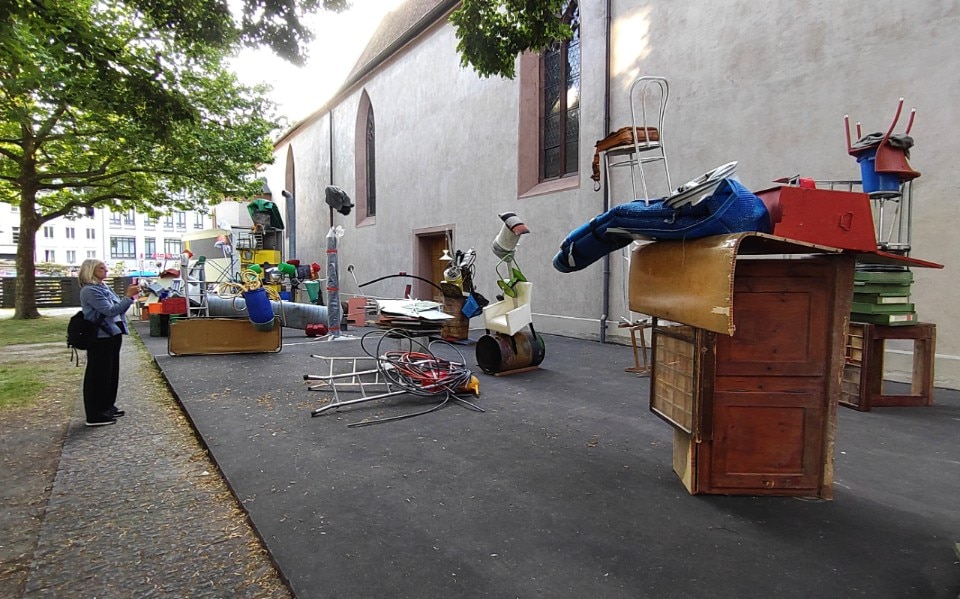
Basel Social Club
Last year’s big novelty, the Basel Social Club – an independent platform created by a collective of artists, gallerists, and curators aiming to establish social spaces for art – bravely attempted to repeat its success this year. Unfortunately, due to autumn weather affecting the event’s setting, it achieved less success.
This alternative edition brought together local and international artists for a program of shows and performances set in 50 hectares of farmland amidst Basel’s rural neighborhood. Interventions were placed in fields, between barns and trees, responding to contemporary ecological themes. Landscape, agriculture, and farm animals were central elements, with guest farmers participating actively, curiously observing as elegantly dressed curators, collectors, and international visitors strolled bucolically through these artistic islands, immersed in nature.
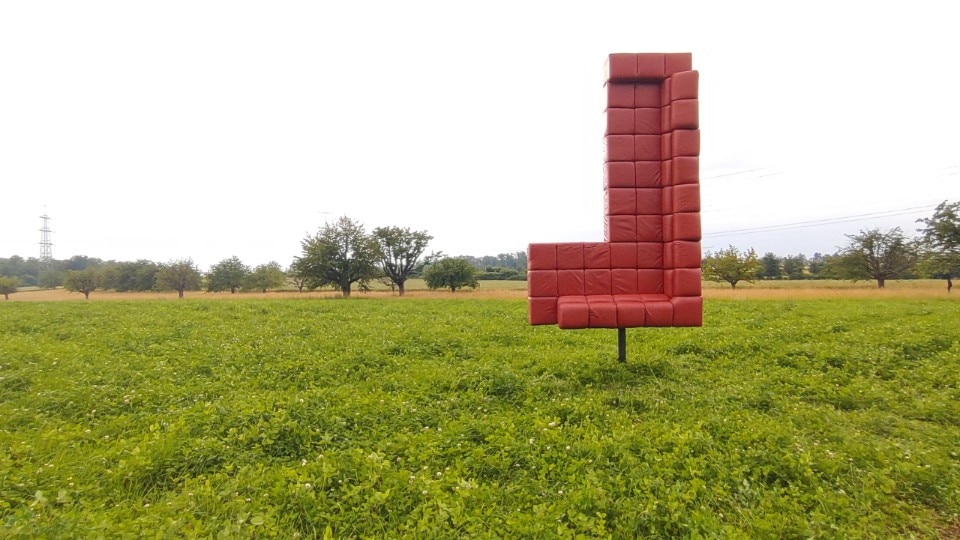
Fondation Beyeler
At Fondation Beyeler, known for its traditional exhibitions of past art but increasingly hosting special events dedicated to contemporary art, something beyond the usual “exhibition” is taking place.
For the first time in its more than 25-year history, the entire museum and its grounds are transformed into a site for experimental contemporary art presentations. With contributions from numerous artists, curated by luminaries like Hans Ulrich Obrist, Philippe Parreno, and Tino Sehgal, this artistic “event” is conceived as a dynamic “living organism.”

Visiting these spaces feels like participating in the installation process itself. Teams of white-gloved workers are in constant motion, shifting artworks to create fresh groupings and connections each day.
In the heart of the exhibition spaces, Carsten Holler’s “Dream Hotel Room 1,” created in collaboration with Adam Haar, offers a unique experience where visitors can book a real room to sleep and dream alone in the museum. Meanwhile, outside, Rirkrit Tiravanija’s work provides food and cocktails, while Fujiko Nakaya occasionally envelops the entire building in a dense white cloud of mist, momentarily obscuring it from view. The innovative signage at the entrance categorizes different exhibits and their admission fees.


